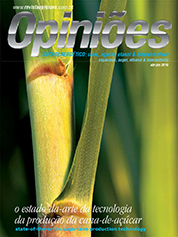Leila Luci Dinardo-Miranda
Director of the R&D Center at IAC
Op-AA-24
Pests and nematodes in sugarcane
The most important sugarcane pests in Brazil are the sugarcane borer Diatraea saccharalis, the root froghopper Mahanarva fimbriolata and the soil pests Migdolus fryanus and Sphenophorus levis. Management of the sugarcane borer is based on the releasing of parasitoids, especially the wasp Cotesia flavipes. In recent years, due to several factors, the borer population had increased and many production units started using chemical control.
Many people are concerned that, because it is easier to adopt, chemical control will gradually gain space in management and will little-by-little become the main tool in pest control. It would be regrettable if this should in fact occur, given that borer control, through the releasing of C. flavipes, has been used in Brazil for many years, with astounding success, and is an efficiency model for biological control. Although chemical control is essential in some situations, its generalized use to control the borer is questionable.
The root froghopper is an important pest throughout mid-South Brazil and in some of the states in the country’s Northeast, where it causes yield reductions of 40-50%, apart from reduction in raw material quality. The losses, however, can be reduced if management techniques are correctly applied. Many units start control applying the Metarhizium anisopliae fungus and, when such applications are not efficient, they apply chemical insecticides, which perform very well, even with a large pest population.
Some farmers, however, are still not aware of the fact that the pest causes significant economic damages even when populations are considered small (the injury level is 3 to 5 insects/m in plantations harvested at the beginning of September), and, for this reason, they adopt control measures at a later than recommended point in time, causing varied damages to the crop.
Among soil pests, termites played more relevant roles in the past. The use of fipronil in the planting of 3 or 4 cycles, due to the high insecticide efficiency, drastically reduced the populations of termites. Nowadays, termites cause damage in much smaller areas than 20 years ago. Nevertheless, many producers use pesticides in almost all their planting areas, aiming solely at termite populations; in many of such areas, insecticides are certainly no longer needed.
It is urgently necessary to become aware of the fact that planting areas (old ratoons and new areas) must be sampled and pesticides applied only in those areas in which pest populations are sufficiently numerous to cause economic losses. M. fryanus larvae cause varied damages to sugarcane, because they destroy the roots and other underground parts of the plant.
Due to this, productivity and longevity are adversely affected. Management involves several control measures (mechanical destruction of infested ratoons, in-depth application of insecticides using a moldboard plow or subsoiler), all of which are not particularly ef-ficient, which is why they should be used together. It is important that infested areas be identified and marked on a map, so that control measures may be adopted when planting the area.
The production cost of in-fested areas is high, however when control measures are not used, the plantation is usually lost following the firsts harvests. Until the 1980’s, S. levis was restricted to the Piracicaba region (State of São Paulo), but it got spread through-out the state, in the North of the State of Paraná and the State of Minas Gerais, through stalks collected in infested areas and used in planting.
The pest has not yet been observed in the states of Goiás and Mato Grosso, but it is highly likely that it is already there too, albeit comprising small populations, insufficient to have been detected during sample collecting. This pest has been the source of great concern because it causes varied damages and it is difficult to control. Damages caused by the larvae are immense; under severe infestations, the stools die and stands faulty stands are observed.
Management involves mechanical destruction of infested ratoons and the application of insecticides in the furrows and/or ratoons; Although insecticides are not particularly efficient (they reduce populations by about 70%), they are important tools in pest management. Problems with S. levis tend to aggravate, because the pest is benefited by the green cane harvest system.
There are two contributing factors: lack of burning, which would kill adults moving on the ground, and the trash coverage that hosts such adults that therefore have their longevity extended. In relation to nematoids, four species are important in Brazil: Meloidogyne javanica, M. incognita, Pratylenchus zeae and P. brachyurus. In areas with large populations and cultivated with susceptible varieties (almost all), nema-todes reduce productivity by up to 50%, both in the sugarcane plant and in ratoons.
Notwithstanding the damages they cause just by existing in large populations in all kinds of soil, and given the economic return of control measures (especially nematicides), this is as yet a problem that has been little addressed by many producers. It is common to find farmers who use insecticides in small pest population areas, but do not apply nematicides where nematode populations are very large. It is therefore important to alert such producers about nematodes. A better approach to this issue would contribute to increase productivity in many regions, without, however, endangering the environment.




